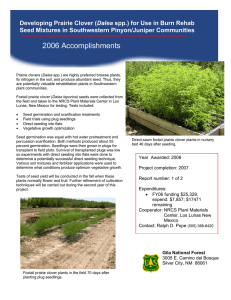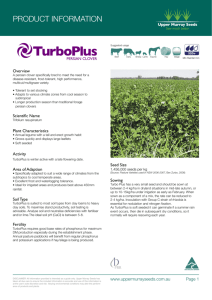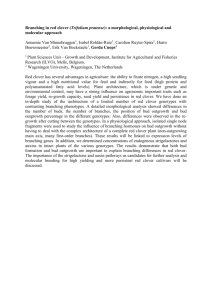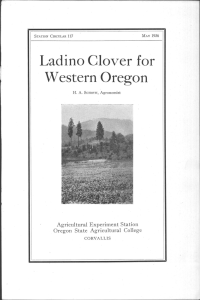FOR COAST AND WILLAtETTE VALLEY SECTIONS.
advertisement
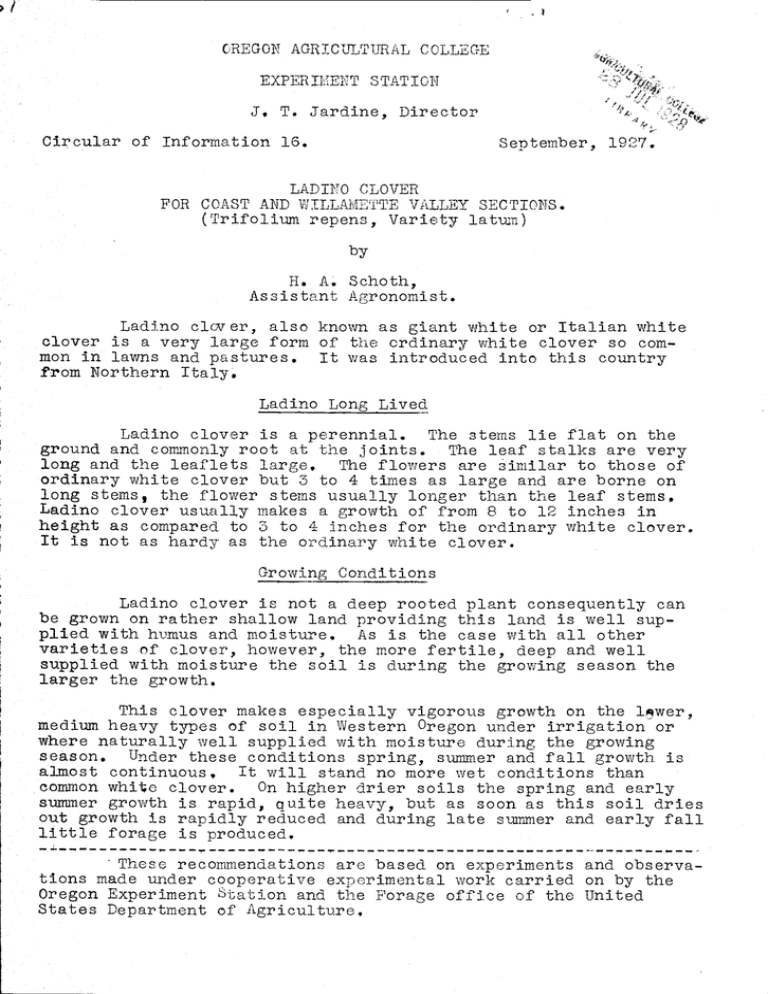
CREGON AGRICULTURAL COLLEGE EXPER IEENT S TAT I OI\T J, T. Jardine, Director Circular of Information 16. September, 1927. LADINO CLOVER FOR COAST AND WILLAtETTE VALLEY SECTIONS. (Trifolium repens, Variety latum) by H. A. Schoth, Assistant Agronomist. Ladino clover, also known as giant white or Italian white clover is a very large form of tile ordinary white clover so common in lawns and pastures. It was introduced into this country from Northern Italy. Ladino Long Lived Ladino clover is a perennial. The sterns lie f'iat on the ground and commonly root at the joints. The leaf stalks are very long and the leaflets large. The flowers are imi1ar to those of ordinary white clover but 3 to 4 times as large and are borne on long stems, the flower stems usually longer than the leaf stems! Ladino clover usually makes a growth of from 8 to 12 inches in height as compared to 3 to 4 inches for the ordinary white clover. It is not as hardy as the ordinary white clover. Growing Conditions Ladino clover is not a deep rooted plant consequently can be grown on rather shallow land providing this land is well supplied with humus and moisture, As is the case with all other varieties of clover, however, the more fertile, deep and well supplied with moisture the soil is during the growing season the larger the growth. This clover makes especially vigorous growth on the lwer, medium heavy types of soil in Western Oregon under irrigation or where naturally well supplied with moistuxe during the growing season. Under these conditions spring, summer and fall growth is almost continuous, It will stand no more wet conditions than common white clover. On higher drier soils the spring and early summer growth is rapid, quite heavy, but as soon as this soil dries out growth is rapidly reduced and during late summer and early fall little forage is produced. Theso recommendations are based on experiments and observations made under cooperative experimental work carried on by the Oregon Experiment station and the Forage office of the United States Department of Agriculture, Bead Bed Preparation Soil preparation for Ladino clover should be such as to produce a fine, firm, weed free seed bed. If the field is to be irrigated it will be absolutely necessary to have it well leveled so that the water can be evenly distributed with as much speed and economy as possible. Early preparation so the land may be worked free from weeds and well settled is important. If the seed bed appears to be too loose and there is danger of getting the seed covered too deep it should be rolled before seeding. Seed and Seeding Use only good seed. Ladino clover seed is so much like common white clover seed that field inspection of the growing crop are necessary to be sure that it is genuine Ladino. As alsike clover seed is insearablo from Ladino, no seed containing much of that kind should be sowed for seed production purposes However, alsikc seed in small quantities does not make the seed objectionable for pasture uses. Seeding is usually done by broadcasting and harrowing the seed in lightly. A clover seed drill that can be gauged to sow shallow and evenly in rather small amounts is an excellent implement to use. Seedings made on land that has never grown white clover or has not grow±i it for several years should be provided with inoculation by either having the seed or soil inoculated before sowing. Four or five pounds of seed an acre are sufficient., if the land is well prepared and comparatively free from weeds. adino clover in yrstr Orogen espocit1ly the Willamette Valley,is most successful when spring seeded. Soed.igs may be made from May 1 to July 1 depending on the season, soil and moisture condition. Fall seedings should ho made early (September 1-20). Fall seedings are not often as successful as spring seedings. Fall sowings on moist land arc likely to heave out. Seedings are best made alone in the Willamette Valley. Under irrigation a light companion crop of 'grain may be used. Makes Pasture, Hay and Seed Ladino clover is grown for hay, pasture, and seed. It is primarily a pasture plant and as such produces a heavy tonnage of rich succulent feed relished by all kinds of livestock and poultry. Whore a considerable acreage is grown the folds should be divided so that rotation posturing can be practiced and full utilization of the crop secured. By this practice any fields not used for pasture can be cut for hay or seed. Ladino clover hould be pastured as evenly as possible but not close enough to injure the creeping stems on the surface of the soil. Ladino clover is best for a hay plant on soils too wet or shallow for alfalfa. For hay, Ladino clover should be cut when the early blooms are beginning to turn brown. The tonnage of hay an acre for each cutting is not large because it consists mostly - 2-. of loaves and leaf stems. Under ordinary mois iaid conditions three cuttings can be made a year, The hay cures very rapidly and has to be handled carefully o secure quantity and quality. When used for both pasture and hay, the spring growth is used for pasture, the early summer growth for hay and later growth for either hay or pasture. Seed production Methods For seed production the spring growth is usually used for pasture. Stock is taken off the fields about May 15 and the growth from then on allowed to mature seed. The crop is ready to cut when 90 per ccnt of the visible heads arc. brown and mature enough to thresh when dry. The seed eay be harvested with a mower with bunching atbachmont and swather or with a self rake reaper. A3 soon as well dried it should bc hulled. The ordinary clover seed huller is very satizfs ctcry. Yields of Seed vary from 100 to 400 pounds an acre, f.s t;hc. plants grow older more seed is ptoducod, providing a fall stend is aaintained. Stands Long Lived Good stands of Ladino clover on suitable land and properly handled should last from four to eight years. It is almost inpossible to keep the stands from getting grassy as they get older. A3 soon as the per cent of grass gets larger than that of clover it is advisoble 1:.o break up thc. sod and plant to other crops unless the quality of the combination is such that it can be profitably utilized as pasture. The use of Ladino clover instead of white clover in pasture mixtures on land reasonably well supplied with summer moisture usually results in increased amounts of pasture. This is especially true in the Coast Districts or where irrigation is practiced. Pasture anagomont Ladino clover, when risturcd or fed green, may cause bloat. Stock subject to this trouble should be watched, closely when being pastured on it. Ladino clover responds very acivcly to spring applications of landplaster. Fifty to sc.vcnty-fivo pounds an acre applied during early i5arch is profitable. Top dressings of well rotted manure results in increased growth. 1arrowing or otherwise scattering ox dropuings n rastured fields in more uniform growth and botla:r use of the crop. results Cultivation to destroy woods and grass is not successful because of the heavy loss of s ems a rid plants duo to the shallow rooting system. Lime in sour soils at one to two tons an acre often holns to secure stands of Ladir&lovor. However, many good stands have been secured wftt/ its use as it appears more suited to slightly acid conditions than semo other clovors. Ladino clover, because of its rather shallow rooting habit, should be watered frequently when grown under irrigation during dry seasons if maximum production is to be secured.
